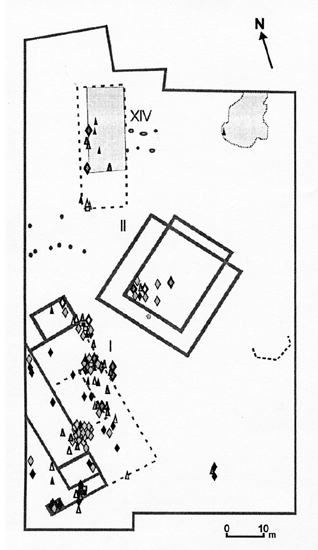Abundant evidence was recovered of offerings made to the god at Uley, both specifically votive objects and everyday items. The evidence for Iron Age and early Roman worship on the site largely derives from the deposits sampled from the pits and ditches beneath the second century AD stone temple. More material remains buried beneath the foundations of the latter. The items deposited included full size weapons and tools, coins, near complete vessels, brooches, fragments of human bone and partially articulated animal remains. By the late Roman period the repertoire of items dedicated to the gods also include specifically votive items that drew on classical religious tradition. Among these were curse tablets, altars and plaques inscribed with dedications to the god and votive 'leaves' in very thin sheet bronze. Also found were figurines of classical gods, models of their attributes and a small number of medical votives representing limbs and perhaps, in one instance a breast. Weapons continued to be offered, but in miniature form. Flat cast copper alloy rings were probably made on the site for worshippers to offer. Among the everyday items many of the hundreds of fourth century coins are likely to have been offered as votives, as are the personal ornaments. By the fourth century the range had extended to include bracelets and pins and rings of jet, shale or bone as well as copper alloy. Some items had been damaged or broken to dedicate them to the god.
Study of the animal bones has revealed patterns in sacrifice. Sheep and goat accounted for 90% of the animal bones and chicken bones for an unusually high percentage of the remainder. This must reflect the adoption of classical patterns of sacrifice to Mercury, both being animals associated with the god. Analysis of the age of the sheep and goats killed suggests that sacrifice peaked in August / September, perhaps in relation to a seasonal festival held at the temple.
Many of the votives were probably originally offered in the temple, perhaps in the central pool or pit, or fixed to the walls of the cella or the ambulatories. Votive material was found in other buildings, especially structures I and IV (see Uley : other buildings). However this probably represents the dispersal of material following the demolition of temple rather than a role in ritual for these structures.
previous: deity next: cult and curses